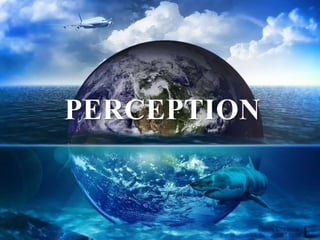
Perception
- 1. PERCEPTION
- 2. PERCEPTION • A process of interpretation of a present stimulus on the basis of past experience • It is an integrated approach. • It is a synthetic process where different physiological and psychological processes are involved.
- 3. Why We Study Perceptions • To better understand how people make attributio ns about events. • We don’t see reality. We interpret what we see a nd call it reality. • The attribution process guides our behavior, reg ardless of the truth of the attribution.
- 4. PERCEPTUAL PROCESS The perceptual process is the sequence of psychological steps that a person uses to organize and interpret information from the outside world.
- 6. PERCEPTUAL SELECTION INTERNAL FACTORS • Personality • Motivation • Experience EXTERNAL FACTORS • Size • Intensity • Contrast • Motion • Repetition
- 7. Internal factors • Personality – Personality traits influence how a person selects perceptions. For instance, conscientious people tend to select details and external stimuli to a greater degree. • Motivation – People will select perceptions according to what they need in the moment. They will favour selections that they think will help them with their current needs, and be more likely to ignore what is irrelevant to their needs. • Experience – The patterns of occurrences or associations one has learned in the past affect current perceptions. The person will select perceptions in a way that fits with what they found in the past.
- 8. External Factors • Size – A larger size makes it more likely an object will be selected. • Intensity –Greater intensity, in brightness, for example, also increases perceptual selection. • Contrast – When a perception stands clearly out against a background, there is a greater likelihood of selection. • Motion – A moving perception is more likely to be selected. • Repetition – Repetition increases perceptual selection.
- 9. Perceptual Organization • Figure Ground • Perceptual grouping • Closure • Proximity • Similarity • Perceptual Constancy • Shape • Size • Colour • Perceptual Context
- 10. Figure- ground Once perceived, objects stand out against their background. This can mean, for instance, that perceptions of something as new can stand out against the background of everything of the same type that is old.
- 11. PERCEPTUAL GROUPING Grouping is when perceptions are brought together into a pattern.
- 12. • Similarity - Similarity between perceptions promotes a tendency to group them together. • Proximity - Perceptions that are physically close to each other are easier to organize into a pattern or whole. • Continuity-Objects arranged in either a straight line or a smooth curve tend to be seen as a unit. • Closure - This is the tendency to try to create wholes out of perceived parts.
- 13. PERCEPTUAL CONSTANCY This means that if an object is perceived always to be or act a certain way, the person will tend to infer that it actually is always that way. • Shape constancy • Size constancy • Colour constancy
- 15. • Selective Perception – People selectively interpret what they see based on their interes ts, background, experience, and attitudes. • Halo Effect – Drawing a general impression about an individual based on a si ngle characteristic. • Contrast Effects – A person’s evaluation is affected by comparisons with other in dividuals recently encountered. • Projection – Attributing one’s own characteristics to other people. • Stereotyping – Judging someone on the basis of your perception of t he group to which that person belongs.
- 16. Recency Effect When the most RECENT information influence our judgement, even though we have a whole of other information on the Person.
- 17. The Similar-to-Me Effect We tend to favour/like or give favourable judgement to those who are similar to us. Example • Two candidates came along for interview, one from Delhi and the other from Bihar. As interviewer is from Delhi, he tend to the candidate from Delhi, better evaluation.
- 18. Fundamental Attribution Error The tendency to underestimate the influence of external factors and overestimate the influence of internal factors when making judgments about the behavior of others.
- 19. Self-Serving Bias The tendency for individuals to attribute their own successes to internal factors while putting the blame for failures on external factors.
- 20. Self-fulfilling prophecy People’s preconceived expectations and beliefs determine their behavior, thus, serving to make their expectations come true